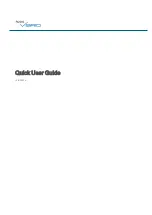
180
D14049.03
MAY 2008
Grey Headline
(continued)
TANDBERG
VIDEO COMMUNICATIONS SERVER
ADMINISTRATOR GUIDE
Regular Expression Reference
Regular expressions can be used in conjunction
with a number of VCS features such as alias
transformations, zone transformations, CPL
policy and ENUM. The VCS uses POSIX format
regular expression syntax.
The table opposite provides a list of
commonly used special characters in
regular expression syntax. This is only
a subset of the full range of expressions
available. For a detailed description of
regular expression syntax see the publication
Mastering Regular Expressions [9]
.
Character
Description
Example
.
Matches any single character.
*
Matches 0 or more repetitions of the previous match.
.*
will match against any sequence of characters.
+
Matches 1 or more repetitions of the previous match.
\
Escapes a regular expression special character.
\d
Matches any decimal digit, i.e. 0-9.
[...]
Matches a set of characters. Each character in the set
can be specified individually, or a range can be specified
by giving the first character in the range followed by the
-
character and then the last character in the range.
You can not use special characters within the
[]
- they
will be taken literally.
[a-z]
will match against any lower case alphabetical character.
[a-zA-Z]
will match against any alphabetical character.
[0-9#*]
will match against any single E.164 character - the E.164 character
set is made up of the digits
0-9
plus the hash key (
#
) and the asterisk key
(
*
).
(...)
Groups a set of matching characters together. Groups
can then be referenced in order using the characters
\1
,
\2
, etc. as part of a replace string.
A regular expression can be constructed to transform a URI containing a
user’s full name to a URI based on their initials.
The regular expression
(.).* _ (.).*(@example.com)
would match against
the user
john _ [email protected]
and with a replace string of
\1\2\3
would transform it to
.
|
Matches against one expression or an alternate
expression.
.*@example.(net|com)
will match against any URI for the domain
example.com
or the domain
example.net
.
^
Signifies the start of a line.
When used immediately after an opening brace, negates
the character set inside the brace.
[^abc]
matches any single character that is NOT one of
a
,
b
or
c
.
$
Signifies the end of a line.
^\d\d\d$
will match any string that is exactly 3 digits long.
(?!...)
Negative lookahead. Defines a subexpression that
must
not
be present in order for there to be a match.
(?!.*@tandberg.net$).*
will match any string that does not end with
@
tandberg.net
.
For an example of regular expression
usage, see the section
.
Overview
Common Regular Expressions
















































